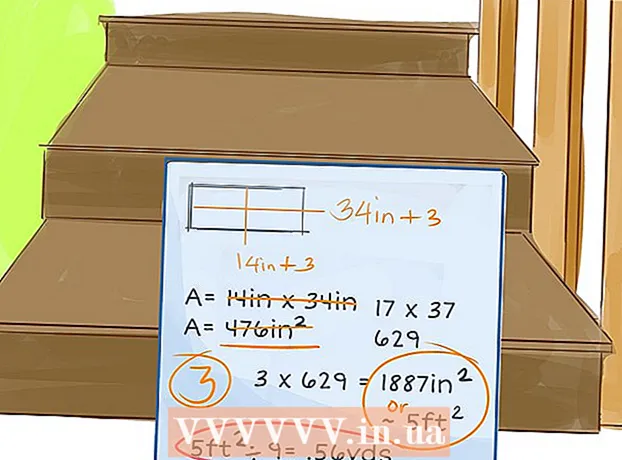
Content
- Ingredients
- Seasoning with dry spices
- Marinade seasoning
- Glaze seasoning
- Seasoning with sauce
- Seasoning whole salmon
- Steps
- Method 1 of 5: Seasoning with dry spices
- Method 2 of 5: Seasoning with marinade
- Method 3 of 5: Frosting
- Method 4 of 5: Seasoning with Sauce
- Method 5 of 5: Seasoning with Whole Salmon
- Tips
- Warnings
- What do you need
Salmon is one of the most versatile fish on the market and makes an excellent "clean leaf" for a variety of seasoning options. This fish is delicious seasoned only with salt and pepper, but the possibilities of using other seasonings are limited only by the imagination of the cook.
Ingredients
Seasoning with dry spices
4 servings
- 0.5 kg salmon fillet
- 1/2 cup (90 g) brown sugar
- 2 tsp (8 grams) crushed red pepper
- 1 tsp (4 grams) black pepper
- 1 tsp (4 grams) dry mustard
Marinade seasoning
4 servings
- 0.5 kg salmon fillet
- 2 tbsp (30 ml) horseradish sauce
- 2 tbsp (30 ml) Dijon mustard
- 2 tbsp (30 ml) oyster sauce
- 2 tbsp (30 ml) soy sauce
- 1/4 cup (60 ml) dry white wine
Glaze seasoning
6-8 servings
- 1 cup (240 g) diced butter
- 1 cup (240 ml) canned peaches
- 1 tbsp (15 ml) freshly squeezed lime juice
- 1 garlic clove, minced
- 1/2 tsp (1 g) prepared mustard
- 1 kg salmon fillet
Seasoning with sauce
6-8 servings
- 1 kg salmon fillet
- 240 g butter
- 1 tbsp (7 grams) cinnamon
- 1 tsp (2 g) dried basil
- 2 cups (150 g) blackberries
- 1/4 cup (50 g) sugar
Seasoning whole salmon
10 servings
- 2 tbsp olive oil
- Whole salmon without guts and scales
- 1/2 tsp salt
- 1/2 tsp freshly ground black pepper
- 15 large garlic cloves, minced
- 2 tbsp. roasted fennel seeds
- 3 sprigs of rosemary
Steps
Method 1 of 5: Seasoning with dry spices
Dry spices are a mixture of dry ingredients that you coat the pink flesh of a salmon fillet with. For a more intense flavor, place the salmon fillets in the refrigerator and let the spices soak into the meat for an hour before cooking. Here's an example of dry spices you can use to season salmon:
- 1 Line a shallow baking dish with aluminum foil. Spray cooking grease on the foil. Preheat oven to 200ºC and start making seasoning.
- 2 Prepare the seasoning. In a small bowl, use a small whisk or fork to combine brown sugar, crushed red pepper, black pepper, and dry mustard. Stir until smooth.
- 3 Place the salmon fillets in a foil-lined baking dish. Lay the fish skin down and flesh up. If your salmon is skinless, you can put it down as you like.
- 4 Sprinkle the dry seasoning over the salmon. Try to cover the fish with an even layer. Use your fingers to rub the seasoning into the salmon flesh.
- 5 Turn the fish over and repeat the process on the other side. Place the salmon again, skin side down, if any.
- 6 Bake the salmon. Cooking time depends on the thickness of the fillet. For every 2.5 cm, it will take 10 minutes to bake. If your fillet is 4 cm thick, it will be done in 15 minutes.
- Be aware that different ovens will cook differently. Keep an eye on cooking salmon if you're unsure about your oven.
- 7 Check if the salmon is cooked. At the end of cooking, check that the salmon is done with a fork; its meat should be easy to separate. If you prefer less cooked salmon, cook it for less time.
- 8 Divide the fillet into 4 equal portions. It's ready to serve!
Method 2 of 5: Seasoning with marinade
Marinating is an easy way to imbue salmon fillets with an intense flavor. However, you will achieve the best results if you leave the salmon to marinate for several hours to allow the flavor to penetrate the carcass. If you have time for this, then it will be worth it. Here's an example of marinating salmon:
- 1 Prepare the marinade. Combine horseradish, mustard, oyster sauce, soy sauce, and wine in a small bowl. Mix thoroughly until smooth.
- 2 Get a 4 liter resealable plastic bag for storing food in the freezer. Pour the marinade into it and add the salmon fillets. Make sure the fish is completely covered in the marinade.
- Place the bag in the refrigerator and refrigerate the salmon for 8 hours or overnight.
- 3 While the oven is heating to 200ºC, line the shallow baking dish with aluminum foil. Spray cooking grease on the foil.
- 4 Transfer the salmon from the bag to a baking dish. Lay the fish skin down and flesh up.
- Throw away the bag of leftover marinade.
- 5 Bake the salmon. Cooking time depends on the thickness of the fillet. For every 2.5 cm, it will take 10 minutes to bake. If your fillet is 4 cm thick, it will be done in 15 minutes.
- The cooking time for salmon is independent of the seasoning method. If you find any other way to prepare salmon, start from the above cooking times.
- 6 Check if the salmon is cooked. At the end of cooking, check that the salmon is done with a fork; its meat should be easy to separate.
- Divide the salmon into 4 equal portions and serve with salad, pasta, vegetables and white wine.
Method 3 of 5: Frosting
The frosting will add sweetness to the salmon fillet. Both marinade and frosting are wet seasoning methods. The difference is that you marinate the fish to infuse the flavor before cooking, and you glaze the salmon after it's cooked.
- 1 Place the butter and peaches in a microwave safe bowl. Cover the bowl with a paper towel and microwave for 45-60 seconds. The butter and peaches should start to combine.
- 2Add lime juice, garlic and mustard and mix thoroughly with a fork or small whisk.
- 3 Pour 1 cup (240 ml) frosting into a separate container. You will pour this mixture over the salmon fillets at the end of the cooking process. Place this frosting in the refrigerator.
- 4 Get a 4 liter resealable plastic bag for storing food in the freezer. Pour the remaining icing into it and add the salmon. Use tongs to flip the fish over for even coverage.
- 5 Refrigerate salmon for 20 minutes. During this time, preheat the oven to 200ºC. Line a metal baking dish with aluminum foil and spray with cooking fat on top.
- 6 Remove the salmon from the bag and discard the remaining marinade. Place the fish skin side down in the baking sheet.
- 7 Bake the salmon for 10 minutes for every 2.5 cm fillet thickness, glaze every 5 minutes. Use the glass (240 ml) of the icing you previously refrigerated and the cooking brush. Lubricate the top of the salmon with icing.
- Test the salmon for cooking by cutting off the flesh with a fork. If you prefer less cooked salmon, cook it for less time.
- 8 Remove the cooked salmon from the oven. Divide into 6-8 servings and serve.
Method 4 of 5: Seasoning with Sauce
Prepared sauce is another way to wet salmon. While the marinade is applied before cooking, the icing during and after cooking, the sauce is simply served on the table along with the finished dish. You can dip the salmon in the sauce or pour over the finished fillet.
- 1 Take a metal baking dish. Line it with aluminum foil and spray with cooking grease on top. Turn the oven to 200º C and start preparing the sauce.
- 2 Place the salmon skin side down on the foil. Brush the top of the fillet with butter using a butter knife. Then sprinkle the fillets with cinnamon and basil.
- 3 Bake the salmon. For the fillets to be well done, bake the salmon for 10 minutes for every 2.5 cm of fillet thickness. If you prefer less cooked salmon, cook it for less time.
- Test the salmon by severing the flesh with a fork.
- 4 Combine the blackberries and sugar in a blender or food processor. Make a smooth berry puree. Transfer to a serving bowl.
- 5Divide the salmon into 6-8 servings and serve with the sauce.
Method 5 of 5: Seasoning with Whole Salmon
To season whole salmon, you will need to process both the skin and the cavity of the fish. Ask the fishmonger to remove the entrails of the salmon and trim the fins and gills.
- 1 Preheat grill to 160 ° C and spray with cooking fat. If the grill is dirty, clean it with a paper towel, a little oil and tongs. This will prevent the salmon from sticking.
- 2 Sprinkle 1/4 teaspoon salt and 1/4 teaspoon pepper on the cavity of the fish. This will improve the flavor.
- 3 Combine 1 tablespoon each of olive oil, garlic and fennel seeds in a small bowl. Fill the salmon cavity with this mixture.
- Place the rosemary sprigs over the garlic and fennel seeds.
- Then cover the fish.
- 4 Rub the skin of the salmon with a mixture of 1 tablespoon olive oil, 1/4 teaspoon salt, and 1/4 teaspoon pepper. Don't be afraid to get your fingers dirty!
- 5Cook the fish for 15-20 minutes or until the skin is translucent.
- 6 Flip the fish over to the other side. Cook for another 15 minutes or until a meat thermometer inserted into the thickest part of the fish reads 55 C.
- 7 Peel the skin from the top side and open the fish, exposing the flesh. Then take out the spine and bones. Discard the minced garlic you used to fill the salmon.
- 8 Use a knife to cut off the head and tail. Divide the rest of the salmon into portions and serve.
Tips
- Buy brightly colored salmon fillets. Do not buy fish if it has a pronounced fishy smell.
Warnings
- Salmon can contain traces of mercury, which is dangerous for pregnant women. Pregnant women should consult their doctor before consuming salmon.
- Wash your hands after handling raw salmon.
What do you need
- Shallow metal baking dish
- Aluminium foil
- Cooking fat
- Small bowl
- Fork or whisk
- 4 liter resealable plastic bag for storing food in the freezer
- Microwave safe bowl
- Paper towels
- Separate container for icing
- Butter knife
- Food processor or blender (for sauce)
- Grill (for whole fish)
- Knife



